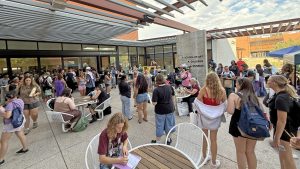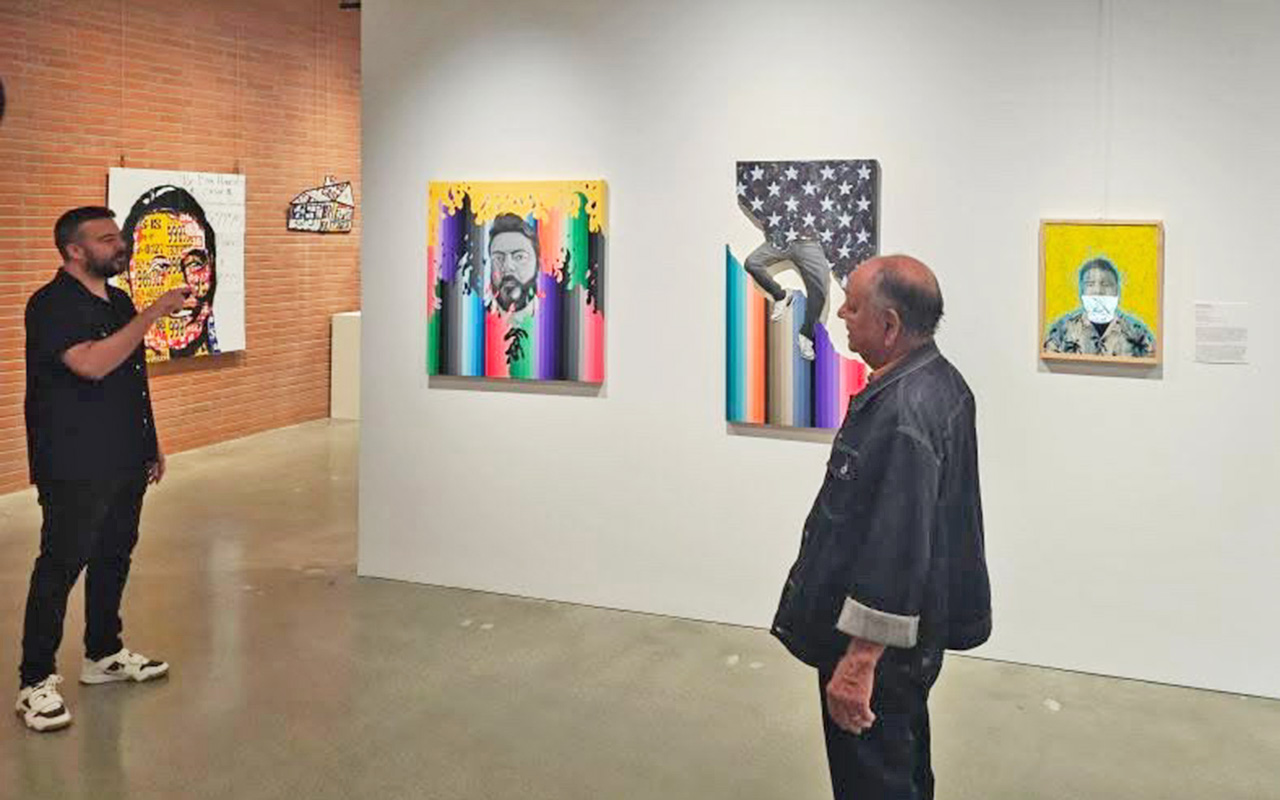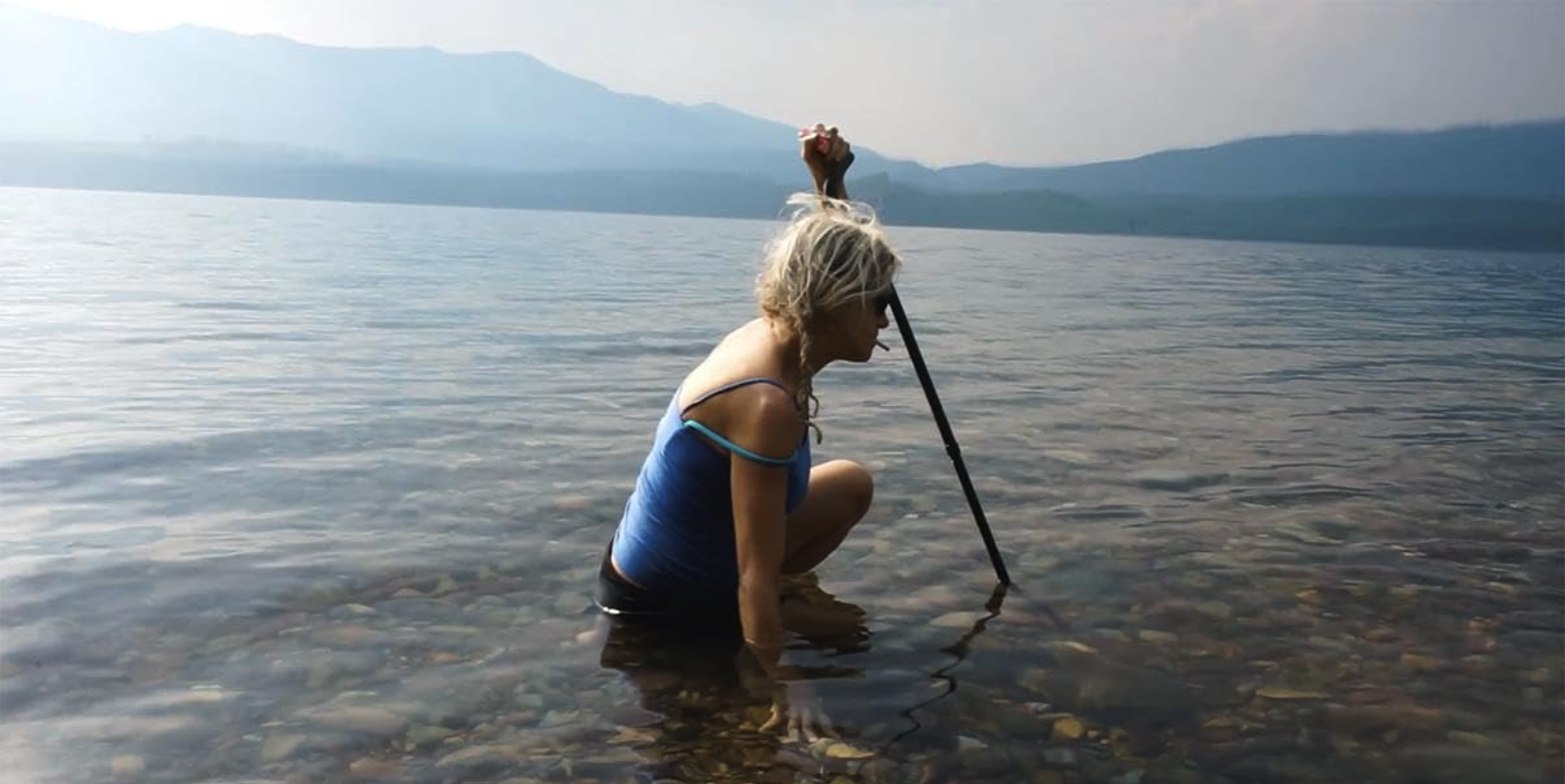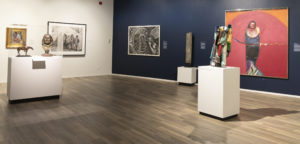
TMA centennial exhibition includes School of Art alums, faculty emeriti
By Michael Chesnick. July 29, 2024Ten artists with University of Arizona School of Art ties are among those featured in “Time Travelers: Foundations, Transformations, and Expansions at the Centennial,” as the Tucson Museum of Art (TMA) and Historic Block celebrates 100 years since its founding with an exhibition that runs until Oct. 6, 2024.
The artists include former faculty members or alums Cristina Cárdenas, Robert Colescott, Maurice Grossman, Luis Alfonso Jiménez Jr., Karlito Espinosa Miller, Tom Philabaum, Howard Post, Alfred Quiroz, Fritz Scholder and Jim Waid.
The museum, 140 N. Main Ave., is open Wednesday through Sunday from 10 a.m. to 5 p.m.
(Images of artists’ work below courtesy of the Tucson Museum of Art and Historic Block)
Cristina Cárdenas (MFA ’90, Printmaking)
Work in exhibition: “Zapatista II,” 1999, lithograph, silkscreen, 8/44. Collection of the Tucson Museum of Art. Anonymous Gift. 2003.18.1.

Bio: Born and raised in Guadalajara, Jalisco, Mexico, Cárdenas is an award-winning painter, printmaker and ceramist based in Tucson. Women are frequently the protagonists of her work, and she gives them a permanent and positive voice. Her draftsmanship, iconography, artistic forms, color and style are derived from Mexican neo-figurative expressionism, which she learned from academic training at the Universidad de Guadalajara, Escuela de Artes Plásticas and at the University of Arizona School of Art.
Quote: “Due to my personal history as an immigrant, the recurring theme in my work responds to and communicates relevant political and personal impressions, such as the right for immigrants to have a path to American citizenship. My work is an exploration of immigration/migration and its effects on culture, family, the loss of los ausentes — the ones who left their homelands and are considered missing in their physical absence, but not in their psychological presence — and the individual in these times of racism.” — From Mexic-Arte Museum interview
- Video: UAMA panel for “Desert Triangle” exhibit
- On the web: ASU Hispanic Research Center and CultureConnect and Arizona Daily Star profile

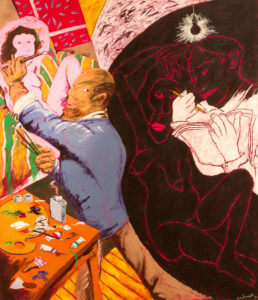
Robert Colescott (Regents Professor Emeritus)
Work in exhibition: “The Light is On: Moroccan Pink to Drip and Smear,” 1991, acrylic gel on canvas. Collection of the Tucson Museum of Art. National Endowment for the Arts Purchase Award and Museum Funds. 1992.2.

Bio: Colescott, who died in 2009 at age 83, was an African-American artist known for his expressionistic paintings which dealt with his identity and Black history. In 1964, he became an artist-in-residence at the American Research Center in Cairo. He accepted a position as a visiting professor at the University of Arizona School of Art in 1983 and joined the faculty in 1985. In 1990, he became the first art department faculty member to be honored with the title of Regents Professor. In his work “George Washington Carver Crossing the Delaware: Page from an American History Textbook” (1975), Colescott humorously conflated the famous Emanuel Gottlieb Leutze painting of George Washington with the pioneering African-American chemist. Colescott was granted emeritus status in 1995, and two years later, he was the first African-American artist to represent the United States in a solo exhibition at the Venice Biennale.
Quote: “Living in Cairo for three years, I felt a profound influence from the three thousand years of a ‘non-white’ art tradition and by living in a culture that is strictly ‘non-white.’ I think that excited me about … some of the ideas about race and culture in our own country. I wanted to say something about it.” — From 1999 interview for Smithsonian Archives of American Art
- On the web: University Communications obituary
Maurice Grossman (Professor Emeritus)
Work in exhibition: “Landscape Vessel,” 1984, raku, oxides. Collection of the Tucson Museum of Art. Gift the Grossman Family. 2011.17.2.

Bio: Grossman, who died in 2010 at age 82, was an artist and LGBT activist who founded the School of Art’s ceramics program in 1956. He started out as a painter, studying watercolor and commercial art at Detroit’s Wayne State University in the 1940s. He taught for nearly 35 years at the University of Arizona, mentoring several generations of students and community leaders, until retiring as a professor emeritus. He continued working on ceramics in his studio and was a constant supporter of the Ceramics Research Center. A lifelong traveler, Grossman incorporated ideas from Buddhism into his work and philosophy of life, and drew inspiration from the architecture of Europe and Asia.
Quote: “I’m in love with the textual quality of clay, the ability to make it talk. … I’ve always loved to experiment. The students propelled me to try new things.” — From Arizona Daily Wildcat 2007 interview
- On the web: Arizona Daily Star obituary and 2007 Tucson Weekly profile

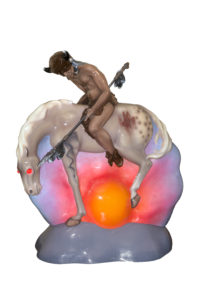
Luis Alfonso Jiménez Jr. (faculty member)
Work in exhibition: “End of the Trail with Electric Sunset,” 1971, fiberglass, resin and epoxy. Collection of the Tucson Museum of Art. The Agnes & Lawrence Heller Fund. 1991.30.

Bio: Jiménez, who died in 2006 at age 65, taught at the School of Art in the 1980s and ’90s. The sculptor and graphic artist was known for portraying Mexican, Southwestern, Hispanic-American and general themes in his public commissions. His most famous large-scale sculptures are “Mesteño/Mustang” (outside Denver International Airport), “Vaquero” (outside Smithsonian American Art Museum in Washington, D.C.) and “Southwest Pietá (in Albuquerque’s Martineztown neighborhood). His “Man on Fire” fiberglass sculpture is on display at the University of Arizona Museum of Art. Jiménez died during the construction of “Mesteño/Mustang” when part of the scuplture swung loose from a hoist in the artist’s studio, severing an artery in his leg. The sculpture was finished posthumously by the artist’s family and installed in 2008.
Quote: “My working-class roots have a lot to do with (my art); I want to create a popular art that ordinary people can relate to as well as people who have degrees in art. That doesn’t mean it has to be watered down.” — From 1995 interview for Smithsonian’s Archives of American Art
- On the web: Arizona Daily Star tribute
Karlito Miller Espinosa (MFA ’19)
Work in exhibition: “Untitled (Nuestra Sonora del Rosario),” 2019, oil on canvas. Collection of the Tucson Museum of Art. Museum Purchase, funds provided by Robert and Sheryl Greenberg. 2019.12.

Bio: Miller Espinosa, aka Mata Ruda, explores themes of politics, migration, regional history, capitalism and institutional violence through sculpture, traditional oil painting and muralism. He was born in San Jose, Costa Rica, and lived in Caracas, Venezuela, before moving to the U.S. when he was 12. He graduated from the Maryland Institute College of Art (MICA) in 2012 with a BFA. Featured on the 2018 BBC Documentary Series “The Art of Now,” he has been invited to travel and paint various commissioned public murals in Russia, Puerto Rico, Ukraine, Mexico and dozens of U.S. cities. After graduating from the School of Art’s MFA program, he was a studio program resident for the prestigious Whitney Independent Studies Program in 2019-2020 and painted the mural on the north side of the school’s Joseph Gross Gallery (facing Speedway Boulevard).
Quote: “I paint with wood stain, plaster, clay, adobe because I don’t just want the work to be a visual representation of ideas. Instead I want it to physically embody the message. The materials are not separate from the story; they carry baggage.” — From fall 2023 Arizona Arts story, after he unveiled the art installation “Esta Tierra es Nuestra Tierra” (“This Land is Our Land”) at the FDR Four Freedoms State Park in New York City.
- Instagram: @mataruda
- On the web: &gallery Q&A and story about School of Art mural
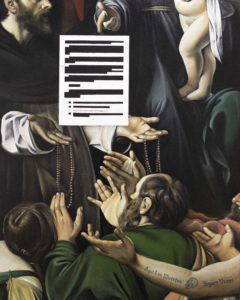
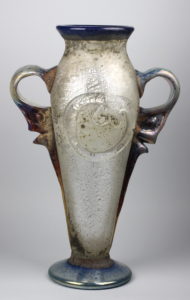
Thomas A. Philabaum (MFA ’83)
Work in exhibition: “Venerable Vessel,” 2000, blown glass with scavo finish. Collection of the Tucson Museum of Art. Gift of Debra Hughes and Gary Tyc. 2009.16.1.

Bio: Philabaum earned his Master’s in glassblowing at the University of Wisconsin-Madison under Harvey Littleton, one of the founders of the American studio glass art movement. Philabaum built his first studio in 1975 in downtown Tucson and opened his first gallery in 1982 on Congress Street before getting his MFA from the School of Art the next year. In 1985, Philabaum and his wife, Dabney, combined the studio and gallery into the Philabaum Glass Gallery, 711 S. Sixth Ave, where he and his team created unique glass art that was shown around the world and in Tucson — from mounted glass flowers on the wall of the University of Arizona’s Highland Market to flying carpets hanging from the ceiling at the Tucson airport. Philabaum, who co-founded the Sonoran Glass School, retired from glassblowing in 2018 but continues to create painted and fused glass, including platters and contemporary wall hangings. One of Philabaum’s lasting contributions is the creation of a two-inch-thick glass disc award, known as a Philabaum, that is used to honor those who work for Pima County.
Quote: “(My glass art) makes me feel … connected to my community and that what I do is part of the community and people value it.” — From 2019 Arizona Alumni interview
- Instagram: @philabaumglassstudio
- On the web: Artist bio; 2020 Arizona Daily Star story about selling his business
Howard Post (BFA ’72, MFA ’78)
Work in exhibition: “The Bull Pen,” 1978, oil on canvas. Collection of the Tucson Museum of Art. Gift of Lynn Taber. 2000.58.1.

Bio: Known for his paintings of cattle, cowboys, rodeo arenas and ranch life executed with a unique aerial perspective and sun-drenched hues, Post is an impressionist painter who portrays the contemporary West in a modern fashion. Born and raised on a ranch near Tucson, he still competes in roping competitions throughout the West but he considers himself an artist rather than a cowboy. After getting his BFA and MFA at Arizona, he taught at the School of Art for two years and worked as a commercial artist until 1980, when he decided to paint full-time.
Quote: “I like to take a bird’s-eye view of cattle clustered in a corral, cowboys perched in fence rails, or a distant ranch house. I like the angularities of fences, and this higher perspective endows people and animals in the painting with stronger shapes and patterns.” — From 2023 interview with Masters of the American West
- Instagram: @howardpostfineart
- Website: howardpostfineart.com


Alfred Quiroz (MFA ’84, Professor Emeritus)
Work in exhibition: “El Azteca Practicando para Sufuturo de Modelo para Calendareo,” 1992, charcoal on paper. Collection of the Tucson Museum of Art. Museum Purchase. Virginia Johnson Fund. 1993.28.

Bio: The art educator and artist, known for his satirical paintings and drawings that examine injustice, taught at the School of Art from 1989-2018, mentoring thousands of other artists. The Tucson High graduate enlisted in the U.S. Navy and served in Vietnam, then used the G.I. Bill to earn a BFA in painting from the San Francisco Art Institute, a MAT in art education from the Rhode Island School of Design and an MFA in painting from Arizona. His work has been exhibited extensively, both nationally and internationally, and featured in publications such as Art in America, Artforum and Art Week. His “MUNEEFI$T DE$TINY” (1996) mixed-media work is on display through Oct. 6 in the “Xicanx: Dreamers + Changemakers” exhibition at the Blue Star Contemporary Art Center in San Antonio.
Quote: “(El Azteca) is a satire of calendars that are produced for Mexican restaurants and especially tortilla factories. It was part of my ‘Happy Quincentenary Series.’ Translated: ‘The Azteca practicing for his future role as a model for tortilla calendars.’ As a kid growing up in Tucson, we always had a calendar that depicted the Aztecs as very sexy individuals, scantily clad and representing the volcanos Popo and Izta (shortened names), and I always thought that’s what they actually looked like.” — From 2024 School of Art interview
- On the web: Xicanx exhibition and artist profile at Tucson Museum of Art
Fritz Scholder (MFA ’64)
Work in exhibition: “American Portrait #28,” 1981, oil on canvas. Collection of the Tucson Museum of Art. Gift of the Artist. 1981.11.1.

Bio: Scholder, who died in 2005 at age 67, produced paintings, monotypes, lithographs and sculptures, and was a major influence for a generation of Native American artists. He studied at Sacramento State University and was invited to the Rockefeller Indian Art Project in 1961 at the University of Arizona, where he received his MFA and then taught at the Institute of American Indian Arts in Santa Fe. His expressionist paintings, in museum collections around the world, broke away from stereotypical Native American roles with a style well known for its distortions, explosive brushwork and vivid colors. His “Another Martyr No. 4” sculpture stands in front of the UA Main Library, and Special Collections also holds 10 lithographs signed by Scholder.
Quote: “As a student, you just are always on edge, you just don’t know — what am I doing? the hardest thing is finding out who you are and who you want to be. … When I got to the University of Arizona … it was the first time that they had an MFA program, and they brought people in from all over as graduate assistants, and I became kind of the leader there and would write manifestos and bug everybody, and the faculty.” — From 1988 interview with Kurt von Meier
- Official website: fritzscholder.com
- On the web: New York Times obituary and Academy of Achievement 1996 video interview

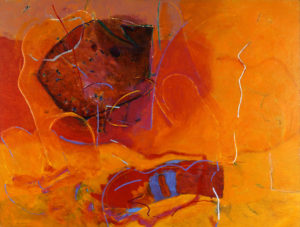
Jim Waid (MFA ’71)
Work in exhibition: “Indio,” 1981, acrylic on canvas. Collection of the Tucson Museum of Art. Gift of Mr. and Mrs. William A. Small, Jr. 1995.133.

Bio: Waid is considered one of Arizona’s most celebrated painters and is included in the public collections nationwide, including the Metropolitan Museum of Art in New York. He creates abstract worlds saturated with color, layered with mark, filled with rhythm and movement, and intricately textured. After receiving a BFA from the University of New Mexico and a MFA from Arizona, he taught art at Pima Community College for nearly a decade. He has been a visiting artist at several universities, including Arizona. He has created two public murals in Tucson: “Sonoran Spring,” at the Dan Eckstrom-Columbus Library; and “Santa Cruz,” at the Evo DeConcini Federal Courthouse.
Quote: “I don’t want the paintings to be like you’re looking at a landscape. I want them to feel like you’re in it.” — From artist statement at Bentley Gallery in Phoenix
- Instagram: @jimwaidart
- Website: jimwaidartist.com
